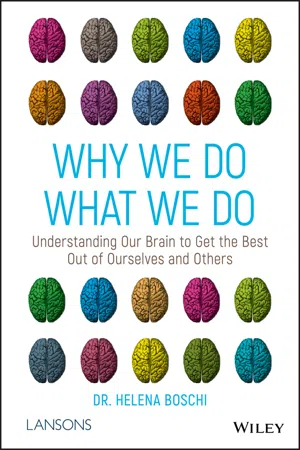
Why We Do What We Do
Understanding Our Brain to Get the Best Out of Ourselves and Others
- English
- ePUB (mobile friendly)
- Available on iOS & Android
Why We Do What We Do
Understanding Our Brain to Get the Best Out of Ourselves and Others
About this book
Practical tools and tips to lead a healthy and productive life
The brain is the basis of everything we do: how we behave, communicate, feel, remember, pay attention, create, influence and decide.
Why We Do What We Do combines scientific research with concrete examples and illustrative stories to clarify the complex mechanisms of the human brain. It offers valuable insights into how our brain works every day, at home and at work, and provides practical ideas and tips to help us lead happy, healthy and productive lives.
• Learn about how your brain functions
• Find out how emotions can be overcome or last a lifetime
• Access your brain's natural ability to focus and concentrate
• Think creatively
The thoughts you have and the words that you speak all have an effect on your neural architecture —and this book explains what that means in a way you can understand.
Frequently asked questions
- Essential is ideal for learners and professionals who enjoy exploring a wide range of subjects. Access the Essential Library with 800,000+ trusted titles and best-sellers across business, personal growth, and the humanities. Includes unlimited reading time and Standard Read Aloud voice.
- Complete: Perfect for advanced learners and researchers needing full, unrestricted access. Unlock 1.4M+ books across hundreds of subjects, including academic and specialized titles. The Complete Plan also includes advanced features like Premium Read Aloud and Research Assistant.
Please note we cannot support devices running on iOS 13 and Android 7 or earlier. Learn more about using the app.
Information
chapter one
Our Brain
‘Sitting on our shoulders is the most complicated object in the known universe.’MICHIO KAKU
Theoretical physicist and futurist (1947–)
ABOUT THIS CHAPTER
Part 1: The science explained
Why we need to keep it all in balance

Our brain, neurons and synapses
- Sensory neurons carry information from our sensory organs – eyes, ears, nose, tongue and skin – to the brain.
- Motor neurons carry messages away from the brain and spinal cord to our muscles.
Our four lobes …

| Frontal lobe | Processes higher cognitive functions and decision-making. This is the centre of our brain's executive functioning and manages complex mental and behavioural responses to the environment. |
| Temporal lobe | Controls our hearing and processes memories, integrates them with our senses and emotions and regulates our endocrine system, which release... |
Table of contents
- Cover
- Table of Contents
- About the Author
- About Lansons
- Acknowledgements
- Preface
- chapter one: Our Brain
- chapter two: Our Brain and Emotion
- chapter three: Our Brain and Memory
- chapter four: Our Brain and Attention
- chapter five: Our Brain and Language
- chapter six: Our Brain and Visual Perception
- chapter seven: Our Brain and Biases
- chapter eight: Our Brain and Creativity
- chapter nine: Our Brain and Change
- chapter ten: Our Brain and Stress
- chapter eleven: Our Brain and Leadership
- chapter twelve: Our Brain and Lifestyle
- And Finally …
- A Note on Neurocomms
- Index
- End User License Agreement